

With the onset of the Civil War, San Bernardino began to see an increase in lawlessness, elements of which extended out into the Mojave Desert. Of particular concern to the citizens of the county was the sharp rise in horse theft, which was often attributed to secessionists who wanted additional mounts for their return home to join the Confederacy.
SILAS COX CHASES HORSE THIEVES TO SAN DIEGO
One victim of theft at the beginning of the war was young Silas Cox, who, upon returning to San Bernardino from a stay on the desert, learned from his father that his favorite horse, Chappo, had just been stolen. He then discovered the thieves were actually men he had spent some time with in the mining region of Holcomb Valley:
I asked father if he had any idea who stole him. He said he thought it was a bunch of young men, mostly gamblers, who had been in Holcomb Valley and San Bernardino for some time. I asked him if they were in town. He said no, that they had all disappeared. After he told me their names I knew them all myself. The most of them were Texas boys, and some of them were pretty good boys. It was just the breaking out of the Civil War, and I suppose they wanted to get back home, but I objected to them taking my Chappo along with them. |
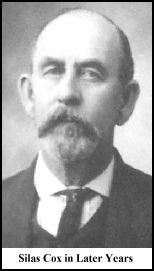
The plucky teenager chased after the thieves and came upon their camp, which consisted of eight men and 12 horses, near the Warner Ranch in San Diego County. Waiting until dark, he sneaked into the camp while the men were asleep, and not only recaptured his own mount, but also got away with all the other horses. Cox said that it was unlikely any of the thieves were able to get back to Texas, at least for some time, and that a few of them actually returned to San Bernardino County and eventually became productive citizens.

HORSE THIEVES TRAFFICKING ON THE DESERT
Other secessionist horse thieves also used the roads leading east and south out of San Bernardino, while some escaped north through Cajon Pass and then traveled east on their return to Texas. However, during 1861 the majority of thefts were committed by local men who were running horses into Utah, and it was speculated that profit was the motive.
After several horse-stealing incidents in April of 1861, the Los Angeles Star commented on the increasing activity, stating, "There seems to be a great demand for horses somewhere in the adjoining Territories, and those in want of them seem to know how to procure them cheap, without cash." Right in the path of the horse thieves trafficking on the upper Mojave was Lane's Crossing. Aaron Lane was in great danger, for the next several months in particular, from criminal elements all around.
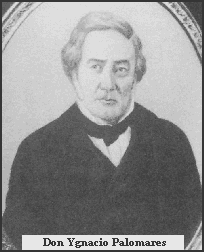
In early June another theft occurred involving Don Ygnacio Palomares, a prominent Californio and owner of the north half of the Rancho San Jose (Pomona), which he called San Jose de Arriba. Palomares had been tending a herd of his cattle on the Mojave, and upon leaving the desert to return to his ranch, he encountered six Americans driving more than 20 of his own cattle, horses and mules out into the desert.
Palomares stopped to pass the time of day and exchange pleasantries with the thieves before hurrying back to his ranch to get help. He and his vaqueros caught up with the thieves, and what was described as a "short contest" took place. One man was killed in the confrontation -- an Indian whom the Americans had placed in charge of the stolen livestock. The Americans escaped with most of the animals, but several mares were recovered, along with the thieves' baggage. Included in the baggage were several daguerreotypes of men "well-known" in San Bernardino.
LOCAL MEN CAPTURED WITH STOLEN HORSES
Several days later, four of the six men were captured while in possession of 23 horses, most of them belonging to Palomares, with the remainder having a sprinkling of different brands. The thieves were all well known, being San Bernardino "Mormons," a term which during these years had become a catch-all that referred to anyone who had ever been connected with the Mormon community, including ex-Mormons, Jack-Mormons, Reorganized Mormons, and people who associated with Mormons. This was the first of several episodes involving Mormon horse thieves to occur over the next few months.
The four men who had been arrested were Roy McBride, Isaac Hawley, Robert Graham and James H. Ferry. Upon reviewing the evidence, the grand jury indicted all four for grand larceny (more than $50), and trial was set for July 6, 1861, with Justice of the Peace Moses Morse presiding.
McBride was tried first, and as his defense he claimed that he had come by the horses honestly and did not know they were stolen. Aaron Lane was called as a witness, probably because he had seen the men and horses, as well as the pursuers, pass by his station.
Since his testimony was not recorded, nor that of the other witnesses, the details of the case are vague. The description of the stolen stock provided by Palomares was given in great detail, listing all brands, marks, colors and distinguishing features. When the jury found McBride guilty, the other three defendants changed their pleas to guilty, and all were sentenced by Judge Morse to two years in state prison.
SOME GANG MEMBERS ELUDE CAPTURE
While the trial was underway, the two other members of the gang, Lot Huntington and William Alma (Al) Williams, who had also been indicted and bench warrants issued for their arrest, were reported as having been seen at the lower crossing of the Mojave River. It was said that the two escaped men swore "vengeance because of their failure, and threatened while at the Mojave to come in three months and get even," a threat which they would make good.
This had to have been an embarrassment for the respectable Mormon community. Al Williams was the brother of Thomas Williams, the merchant killed by Indians and buried at Bitter Springs the year prior. It is somewhat ironic that Al Williams had been living with Justice Morse during the previous year, which is shown by the 1860 census, and for that matter may yet have been living with him when the Palomares theft occurred.
Lot Huntington's father, Dimick, was the brother of William Dresser Huntington, a prominent Mormon in San Bernardino. William Huntington’s son Heber, Lot's cousin, was later the owner of a way station in the 1870s, in what is now Victorville.
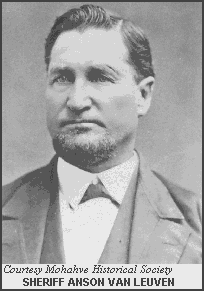
Sheriff Anson Van Leuven assembled a posse of seventeen men to pursue the two fugitives in the desert. The posse was within a few miles of where the culprits were thought to be when trouble broke out. The men started to argue among themselves and a shoot-out began between the members of the posse. Guns blazed and bullets flew, and when it was over, four men were wounded, two "desperately" so. The group was forced to abandon the chase, and returned empty-handed to San Bernardino.
MAT WELCH AND JOHN DOYLE LEE
Concurrent with the McBride case was that of two other local Mormons, James Madison (Mat) Welch and Jacob Harris, both accused of horse thievery. The same July 1861 issue of the Star that reported there was "a plentiful crop of convictions for grand larceny of late," also mentioned the new defendants, saying that they had "heard of the name of but one of the latter batch -- one Mat. Welch, who is well known as an old resident of San Bernardino."
Welch had been in trouble before. He and two other men, Henry Roof and John D. Lee, had been involved in a criminal case that was heard before the grand jury in February. Henry Roof was a former San Bernardino County supervisor, and John D. Lee, if it was John Doyle Lee, was later executed in 1877 for the Mountain Meadows Massacre, the only one of the murderers brought to justice.
John Doyle Lee would not have shown his face in San Bernardino County in those days, but his home in southern Utah would have been ideal as a rendezvous for stolen horses coming from California. Several persons named in the subpoena were found guilty of horse stealing in a later case, adding to the likelihood that these men were involved in some criminal activity around the beginning of 1861. The suspicion that Lee was involved led to his indictment in California. Of Course, it is possible that the John D. Lee in the subpoena is an entirely different man. A John D. Lee does appear in Colton many years later.
In the case of Welch, Roof and Lee, the evidence was not strong enough for the grand jury to issue indictments.
THE WELCH AND HARRIS TRIAL
In the trial for Welch's July offense, with codefendant Jacob Harris, one of the witnesses for the defense was Dorcas Cole, who had married Welch the previous November. She had been married twice before, her second husband having been Mat Welch's prior codefendant, Henry Roof.
Interestingly, she testified under the name of Cole, and there is no evidence that she acknowledged any legal binds to Welch in court. Her testimony seems to have been suspect anyway, as one of the instructions to the jury specified, "...if they believe that the testimony of Dorcas Cole has been successfully impeached, they will wholly discard it from their minds in making up a verdict."
The defense called several other witnesses, the reliability of whose testimony must have been questionable, because at least three of them, Peter Sprague, Thomas Emerson and Jacob's brother, Daniel Harris, would themselves be found guilty of grand larceny within months. Others, including Clark Fabun, Riley Morse, Willard Nichols and James Puffer, were close associates of the prisoners.
Since the defendants were found in possession of a stolen horse belonging to George Yager, the case hinged on the testimony of the defense witnesses, many of whom sought to provide alibis for the two men for the time when the crime was supposed to have occurred. The jury -- whose foreman, E. H. Thomas, was a neighbor of many of these people -- apparently struggled over the trustworthiness of the testimony, because the panelists were unable to reach a verdict.
The judge told them to try again, and upon reconsideration they found Welch guilty of petit larceny, for which he received a fine of $250. Harris, who was tried separately, was found not guilty.
As can be seen by these trials, the citizens of San Bernardino were not exempt from prosecution, contrary to the opinion of Major James Carleton that the town's justice system was a travesty owing to what he described as "undue Mormon influence."
He believed it was impossible for justice to be served in predominantly Mormon San Bernardino, complaining that "the county judge is a Mormon, the sheriff is a Mormon, the justice of the peace is a Mormon. In all ordinary trials the most of the jurymen would be Mormons. You can foresee that the administration of civil law by these officers would continue to be, as it doubtless is now, a farce." It is evident, judging from the previous cases and the number of criminals found guilty in the following months, that Carleton's criticism is unjustified.

CITIZENS ON DESERT LEFT UNPROTECTED
To add to the concerns of the community during this time was the closure of Fort Tejon and Fort Mojave. It was felt by Aaron Lane and the others who either lived in or traveled in the desert that they had been given up to the mercy of the criminals and the Indians. The desert was now wide open to outlaws, and the Indians had become so bold that they even threatened to take any stock that was not removed from the region.
As a result, in June of 1861 there was a "general stampede" out of the desert by the cattlemen who used the upper Mojave River area for grazing their animals. Palomares removed his stock, as did John Rowland of Los Angeles. Henry Parrish and the Bemis brothers, all San Bernardino stockmen, thought it wise to follow their example and also brought their herds down from the desert.
Articles appeared in the Star calling for military assistance. One correspondent from Cajon Pass felt that one or two companies of soldiers were needed to protect the citizens on the desert. Another writer suggested that rather than concentrating the troops in Los Angeles, it would be expedient to station a force at Las Vegas in order to protect the residents and travelers along the Salt Lake Road.
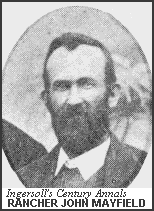
Shortly following the withdrawal of the troops from the desert -- an action which may or may not have been directly responsible for this incident -- Indians did steal some mules from a desert traveler. John Mayfield, a San Bernardino rancher, was on his way to try his luck in the mines at Potosi, Nevada, and had stopped at the Fish Ponds.
While encamped there, some Indians shot his saddle mule and two horses, and ran off with his other mules. To the misfortune of the Indians, Mayfield had friends waiting for him just down the river at Forks of the Road. One of these friends, E. W. Champlin, also of San Bernardino, later informed the press that after a twelve-day pursuit, the mules were retrieved. The fate of the Indians was not included in the story.

A HOTBED OF LAWLESSNESS AND DISORDER
Throughout this time San Bernardino had been plagued with problems other than gangs of horse thieves and hostile Indians. The town held a sizable contingent of Confederate sympathizers, many of whom were causing disruptions in the streets, plus large numbers of unprincipled and desperate men were filtering in from other parts of California and the West.
Some of the citizens had begun to express concern that the community was becoming a hotbed of lawlessness and disorder. Edwin Sherman, editor of the San Bernardino Weekly Patriot, wrote a letter dated June 3, 1861, apprising the Pacific Division commander of the situation as he saw it:
Secret meetings continue to be held all over this lower country, and secession and disunion is boldly avowed in our streets. Shooting continues to be the order of the day, and drunken desperadoes and Southern cutthroats damn the Stars and Stripes and endeavor to create disturbances all of the time. We have a singular population, composed of Mormons, Mormon apostates, who are even worse, gamblers, English Jews, and the devil's own population to boot, while we only have about a dozen good respectable families right in town, who are at the mercy of these desperadoes.... |
CARLETON DENOUNCES GENERAL POPULACE
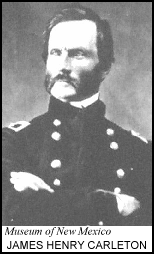
Major Carleton was sent to San Bernardino in July to assess the extent of the secessionist activity. The subsequent report he submitted on the situation in San Bernardino may have reflected his personal sentiments toward the Latter-day Saints.
The Major was decidedly anti-Mormon, as were most military men following the Mormon War, but Carleton had a particular reason for disliking them. His enmity was the result of an assignment in 1859 in which he was sent to the scene of the Mountain Meadows Massacre in Utah with orders to bury the remains of the victims and investigate the circumstances surrounding the heinous crime.
His resultant report to the military was published two years later in the Los Angeles Star as a four-part series, beginning with the June 8, 1861, issue. He described the scene in May of 1859 as still horrible to look upon. The bones of little children were scattered about, women's hair still hung in clumps from the bushes, and bleached skulls and bones stretched for an area of two square miles.
The report was very specific; it named those responsible, and detailed the terrible plan conceived and carried out under the direction of what he called "Latter Day Devils." Those Californians reading the report might have agreed with Carleton when he heatedly remarked, "...how inadequate would be the punishment of a few, even by death, for this crime which nearly the whole Mormon population, from Brigham Young down, were more or less instrumental in perpetrating."
With Carleton still carrying the painful memories of the carnage at Mountain Meadows, and what with the rampant criminal and seditious activity occurring in San Bernardino during his investigation, it is hardly surprising that when he submitted his report to General D. C. Buell, he was even more scathing than editor Edwin Sherman in his denunciation of the general populace. Carleton sincerely believed there were few in the town who had principles enough to feel anything like patriotism.
He felt that measures
needed to be taken by the military, and stated that the
presence of "two or more companies of U. S. troops would
encourage and sustain their loyalty to the Union all those
who yet have reverence for it, would bring back the wavering,
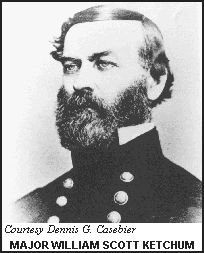 and would exercise a wholesome restraint over the treasonable
and vicious." Carleton estimated that 1,000 of the 1500 people
then in town were Mormons, and, in his opinion, most of the
remaining 500 were also of doubtful character.
and would exercise a wholesome restraint over the treasonable
and vicious." Carleton estimated that 1,000 of the 1500 people
then in town were Mormons, and, in his opinion, most of the
remaining 500 were also of doubtful character.
On August 25th, Major W. Scott Ketchum arrived in San Bernardino with Companies "D" and "G" of the 4th U. S. Infantry, and two more companies were on the way. The troops remained until March of 1862, at an encampment known as Camp Carleton, which was located near the Timber Settlement. As time progressed, it can be seen through the dispatches of the officers that they came to distinguish between the Mormons, trusting some, especially Judge Boren, but they never did have complete confidence in the loyalty of the general community.

REPORTS OF CRIMINAL AND SECESSIONIST ACTIVITY
While Carleton was still assessing the need for assigning troops to San Bernardino, a number of prominent citizens from the city, and from Los Angeles, wrote to the military about their apprehensions regarding certain elements in their communities. Abel Stearns wrote of troublemakers among the Californios and Mexicans in Los Angeles, and said he was also worried about the Mormons, "whose hostility to our Government is well known, and who at any time may join the secessionists in our midst."
San Bernardino attorney Henry M. Willis, while campaigning for political office in Holcomb Valley, had gained information of secessionist activity in that area, and in an August 5th letter to Major Carleton, he specified those whom he thought to be involved, and gave detailed descriptions of their plans.
He reported that a Major Rollins, "the leader and moving spirit" of the secessionist effort, had been sent for out on the Mojave to address meetings in Bear and Holcomb Valleys. This implies that Rollins was headquartered on the desert, and is the first reference of many that some sort of encampment existed there. Many of the secessionist meetings were held in the Holcomb Valley store of Samuel Kelsey, who was described as enterprising, cautious and brave, and was said to instill treason into the youth of the county "with the subtlety of the devil."
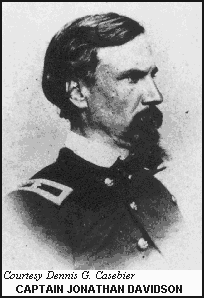
In a dispatch dated August 13, 1861, U. S. Army Captain Jonathan Davidson of the 1st Dragoons, recognizing that the desert was being used for illegal activities, recommended that a military outpost be established at Martin's Ranch in Cajon Pass. A few weeks later Davidson, who had been ordered to San Bernardino with a contingent of dragoons and infantry, submitted a report stating he was convinced that the Mojave was to be a staging area for secessionists planning to commit robberies in the vicinities of Los Angeles and San Bernardino and then leave the state.
He said he knew that the "point of concentration" was on the Mojave and that a number of men had already arrived, but just exactly where this encampment was he did not know. This report has some credibility, because the desert, not only ideal as a rendezvous point and hiding place for gangs of horse thieves, was also the perfect location for a secessionist hideaway; it was convenient to the mining camps in Holcomb Valley -- an area that harbored a large number of Confederate sympathizers -- and was away from the scrutiny of both the military and civil authorities. However, the actual existence of any secessionist encampments on the desert was never confirmed, even though the military searched the Mojave for months.
Also during the month of August the Los Angeles Star had released a news story about a gang of outlaws from Salt Lake City headed by a man named Button, who, according to the report, was "a Mormon spy, or worse," operating out of a location in the town of San Bernardino that had become widely known as Whisky Point (in the vicinity of present-day Third and D Streets).
The Button Gang was purported to have made an unprovoked attack upon a responsible citizen, and the inference in the story was that the entire populace was in some danger from these "Salt Lake ruffians." The reporter asked, Why didn't Sheriff Anson Van Leuven arrest these fellows? Why didn't Major Carleton take charge? In what may have been an attempt to get Carleton's attention, the writer asserted that this was the gang that had destroyed a monument the Major had built at Mountain Meadows; and even further, he went on to accuse the gang of participating in the massacre itself, making the pronouncement, "...we are satisfied they took part in that fearful tragedy."
In this instance, it appears the Star far exceeded acceptable boundaries in its condemnation of the Mormons -- there was no evidence proffered for any of these accusations. Members of the community quite justifiably complained about the slanderous characterizations, as they saw them, being published by the newspaper.

One impertinent Star correspondent, siding with the paper, wrote that the truthful portrayal of "transient Salt Lakers" in the newspaper "has called down the ire and abuse of this amiable class of our community." The transients to whom the writer refers must have been the many Mormon families who had returned to Utah, only to find they could no longer live under the autocratic rule of Brigham Young, and were now seemingly uprooted and dispossessed, traveling from place to place.
Several years had passed since the Star had been an admirer of the Mormons and described them in complimentary terms. This change in attitude can be seen from the time of the Mountain Meadows Massacre. And during the Civil War years, since the paper was very pro-Southern, it was probably occasionally inclined to blame Mormons for some of the criminal activity that could otherwise be placed with the secessionist movement. The article on the Button gang is an excellent example.
The paper's accusation that the men lingering in the vicinity of Whisky Point were Mormon spies was refuted by Henry Willis, who, as both prosecutor and defense attorney in San Bernardino, was in a position to know the truth of those charges having to do with the local area. In his August 5th letter to Major Carleton, Willis gave a very different slant on the situation at Whisky Point:
Disregard the reports you read in the Los Angeles Star about the Mormons and Whisky Point. They and the men that reside there are Union men, and in this matter are unjustly libeled by a secessionist paper. |
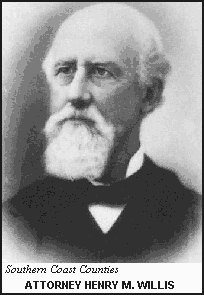
Willis was pro-Union, and had gone on to suggest that a company of troops stationed in the area might help subdue the "secession spirit," yet despite the arrival of the military in late August, the turmoil and crime still continued in San Bernardino County.

OUTLAWRY INCREASES
On September 11th, the grand jury issued indictments against five prisoners for horse theft, all of whom were found guilty. The court seemed to be losing patience with these fellows; those who were found guilty of grand larceny now received sentences of three years in state prison, as opposed to the earlier sentences of only two years for that offense.
The September newspapers carried several stories on the increasing problem of outlaws and horse thieves in the San Bernardino area. According to one article, "...the gang of thieves who lately inundated San Bernardino from Salt Lake, running off the stock of rancheros, still hold sway among and almost over the people of that community." Thugs were said to be roaming about with "knife or pistol in hand," boldly accosting citizens on the streets and businessmen in their stores. Ranchers were advised to keep a stricter watch on their stock.
Vigilant law officers had succeeded in capturing several of the troublemakers. Six persons were already in jail, and a grand jury investigation was pending for the "case of three gentlemen just brought in from the Mojave, having stolen horses and saddles in their possession." These three said they were stealing for the cause of the Confederacy, but the Star editor was of a different opinion: "The thieves called themselves secessionists, but in this they lie. They are just what they always were -- thieves."
The three "gentlemen" were W. L. Bevart, G. C. Snodgrass and Thomas Emerson, who was a defense witness in the People v Welch and Harris. All three were convicted of grand larceny and sentenced to three years in San Quentin.
The Los Angeles Star was convinced that Mormons were mostly behind the crime wave, with profit being the motive -- contrary to the military, who saw the outlawry as originating with secessionists and their treasonous activities. Though anti-Mormon and pro-Southern, the newspaper -- at least as far as horse theft was concerned -- seems to have accurately depicted the course of events. The paper listed the names of the miscreants in most cases, and followed up with the details of their trials and sentencing.
The Star continued its coverage of the crime wave throughout the month of October, and also kept an eye on the military’s progress in its pursuit of secessionists. Since their arrival in San Bernardino, Major Ketchum and Captain Davidson had been kept busy chasing down rumored secessionist plots in the area, primarily in San Bernardino, Holcomb Valley and in the Mojave Desert. After devoting several weeks to this endeavor, they had nothing to show for their efforts. The editor of the Star could not resist making a derisive comment about the Army’s lack of success:
The Horse Thieves. -- Had the military authorities been desirous of making themselves useful in aiding the officers to capture the horse thieves, they had a fine opportunity of doing so, by riding towards the Mojave. But no, they must go on scouts after Secessionists! And a pretty wild goose chase they have made of it! Wonder if Captain Davidson has overtaken that will-o'-the wisp! |
CRIMINAL ACTIVITY CENTERED IN DESERT
It is unlikely that the exact nature of the criminal problem in the fall of 1861 will ever be determined with any certainty from this point in time, especially since the contemporary sources could not even agree on the issue, but whatever its nature, the criminal activity was centered in the desert and affected Aaron Lane directly. What is certain is that many of the leading stockmen in Los Angeles suffered losses to horse theft, the Star and the military agreed that an encampment existed on the desert, and horses that were gathered there were being forwarded on to Salt Lake City.
Whoever it was behind all of this, the situation was dangerous, and rumors flew. There was even a report that Aaron had been killed in a shoot-out that supposedly took place between peace officers and secessionists at Lane's Crossing, but the paper assured everyone that the rumors of his demise were false:
The reported death of Mr. Lane, of the Mojave, is untrue. He is doing all that he can, by keeping up a strict watch and ward over his crossing of the river, to prevent the passage, and stop the progress of the horse thieves. |
On October 5th, the Star reported it had received "reliable information" that there had been a rendezvous on the Mojave, and that large bands of horses were being driven towards Salt Lake. The thieves had just spent several days pasturing their stock at Las Vegas. One band had 150 head of horses alone, and the Palomares brand had been recognized along with those of other local rancheros.
Seen in the vicinity were the "notorious" Lot Huntington, Riley Morse and Al Williams, and all were reported as being well mounted. Huntington was believed to have been riding a large claybank horse carrying the Palomares brand.
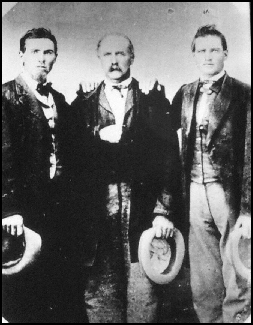
NEW SHERIFF PURSUES HORSE THIEVES
Months had now passed since the rampant horse theft first began, but the worst of it was soon to be over. The fall elections had taken place on September 4, 1861, and one of the offices on the ballot was that of county sheriff. Following a vote count made tardy by the slow receipt of ballot boxes from remote precincts, the official results had been approved on September 16th, and certificates issued to the duly elected officers. Eli Smith had won the election for sheriff, and one of his first acts after taking office was to assemble a posse and pursue the horse thieves.
A San Bernardino correspondent informed the Star that he had received a letter from Sheriff Smith, posted at Fish Ponds, in which the sheriff reported that he was on the thieves' track, "with some prospect of catching them." The correspondent had confidence in the new sheriff, and concluded, "Mr. Smith don't know any such word as fail." At this same time, another party of seven men started out to pursue the horse thieves, but this group gave up when they found out that the outlaws they were tracking were "numerous...and well armed."
These failed vigilantes would have had a taste of glory had they joined forces with the sheriff, because the following week news was received that Smith had been able to capture three prisoners and recover 40 head of horses. This caused quite a stir, and earned him effusive praise from the Star:
This is the most important movement ever made, of this kind, in this lower country, and reflects the highest credit on the sagacity, the courage and enterprise of Mr. Smith. He penetrated into the very camp of the outlaws, and carried off their booty. The confidence reposed in Mr. Smith by the voters of the county, has already been amply vindicated. One of the prisoners effected his escape on the Mojave, but as he was left without provisions, boots, hat or coat, his capture is certain. |
As it so happened, the Star was once again justified in its opinion that most of the thefts were being perpetrated by Mormons. The outlaws captured by Sheriff Smith turned out to be three local men, brothers Daniel and Jacob Harris and Peter Sprague. Justice was swift in those days. In this case indictments were issued by the grand jury, the defendants tried, and the verdicts and sentences published in the newspaper, all by early November.
The Star announced on November 5, 1861, that Sheriff Smith had boarded the steamer Senator at the port of Los Angeles, together with his "traveling companions," Peter Sprague and Daniel Harris. These two, the paper said, would be boarders at the state hotel at San Quentin, where Sprague would be provided with board and lodging for five years. Harris was "not so lucky," the reporter quipped, since he would have "only a four years engagement." The outcome of the case against Jacob Harris is unknown, as there was no information that could be found in either the newspaper or in the court records.

GANG HAS TIES TO THE BLACKBURN BROTHERS
It is likely that Aaron Lane knew some of the men involved in these thefts, as several were from the east end of town near the Timber Settlement where he had lived. A connection tying some of these culprits together is the Blackburn brothers, with whom Aaron was acquainted.
Thomas and Abner Levi Blackburn were early pioneers who shared a cabin in the fort at San Bernardino during the first part of the 1850s. Convict Peter Sprague is recorded as living with the Thomas Blackburn family in 1860, on their ranch located in the City Creek Settlement. Thomas died in 1863, and his widow, Emily, married convicted horse thief Isaac Hawley the following year.
Abner was a brother-in-law of the Harris brothers, having married their sister, Lucinda. The father of Jacob, Daniel and Lucinda was John Harris, who was also one of San Bernardino's original pioneers. After leaving the fort, John moved his family of seven children to Old San Bernardino, just across the river from the Timber Settlement. Abner was subpoenaed by the grand jury in the Harris and Sprague case tried in October, but he could not be located by Deputy William Levick, who notified the court that he had "ascertained that [Blackburn] is not in the County."
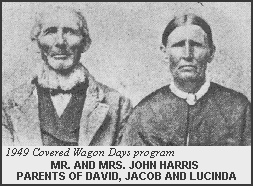
Another tie to the gang of horse thieves was Abner's relationship by marriage to Clark Fabun, who had married another Harris daughter, Susannah. Fabun had provided a bail bond and served as a witness in the case involving Welch and Harris.
There is nothing in the court records to indicate that any Blackburns themselves were ever involved in the thefts in San Bernardino. Abner served as a trial juror both in the September 1861 and February 1862 court sessions, and he would not likely have been called if he were under any kind of suspicion.
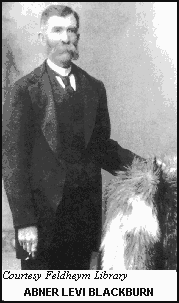
It should be mentioned, though, that Abner's past is allegedly not without blemish. There is a family tradition that he stole six mules from Mormon leader Brigham Young himself, and the men sent out to recover them never returned. However, this account could simply be a myth.
THE MOTIVATION FOR THE HORSE THEFTS
Just what caused this flurry of horse thievery in San Bernardino County cannot be stated decidedly. The offenders for the most part were not professional outlaws, so there must have been a feeling of opportunity provided by the Civil War for those who might otherwise have followed the straight and narrow path.
Many of the thieves may very well have belonged to that group of people referred to earlier as "transient Salt Lakers" -- Mormons without permanent roots. Of those who had answered Brigham Young's call to return to Utah in 1857, even the most faithful chafed at the tyrannical rule of this despot.
The San Bernardino Mormons had grown accustomed to the liberal regime of Amasa Lyman, Church leader and co-owner of the Rancho San Bernardino, and they resented some of the more odious intrusions of the Church into their family life. Many returned to San Bernardino over the years, some as early as 1858.
If some of the thieves were indeed transient Salt Lakers, it would explain much about their involvement in such a risky pursuit. Men who had lost their investments in the community, restless and discontented, might be tempted by the prospect of adventure and easy money.
It is also possible the Mormon horse thieves did not see their actions as criminal, but rather as heroic. During the Mormon War, the members of Utah's militia who had harassed the U. S. Army troops were seen as heroes. For years the Mormon hierarchy had preached that their people had been abused, that they should not again fall victim to mob rule as they had in Missouri and Illinois, and that the United States, or the United States Army at least, was their enemy.
The exploits of Lot Smith, in particular, delighted Mormons. He was the leader of a small band of zealots who, during the U. S. Army's incursion into Utah in 1857, burned three government supply trains, set fire to grasses on the plains to deny fodder for the enemy's stock, and drove off 1400 head of government cattle, among other daring feats. His attacks were audacious and astounding, and took place under the very noses of Colonel Albert Sidney Johnston's troops.
Admiration for these exploits was only natural during a period of war. However, since anti-U.S. sentiment still ran high in the Mormon community, it is conceivable that the criminals in San Bernardino saw the theft of the "enemy's" horses as anything but dishonorable. In their eyes they may have been the modern David defeating Goliath.
DESERT NO LONGER ROUTE FOR HORSE THIEVES
After Sheriff Smith's capture of the Harris brothers and Peter Sprague, and with a large number of the gang behind bars -- McBride, Hawley, Emerson and the others -- the incidents involving Mormons came to a halt. Those of the gang who managed to elude the sheriff, had departed for Utah. A total of eighteen men from San Bernardino County had been convicted of grand larceny and "provided with comfortable quarters" in the state prison.
There continued to be outbreaks of raids by horse thieves, but their destination was no longer Utah. The mines of New Mexico were thought to be the new locale for the disposition of horses stolen from California.
This had the effect of shifting the hot spot of crime away from Lane's Crossing, or at least diversifying it, since a sizable percentage of thieves would be more apt to use San Gorgonio Pass, or the route through Warner's stage stop in San Diego County, to escape the state. The turmoil on the desert had abated considerably, but nevertheless, the Mojave River settlers still had some exciting times in store for them.

 PAGE
1|
2|
3|
4|
5|
6|
7|
8|
9|
10|
11|
12
PAGE
1|
2|
3|
4|
5|
6|
7|
8|
9|
10|
11|
12

